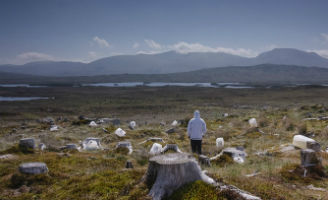
MADRID – The Museo Nacional Thyssen-Bornemisza is presenting, together with TBA21-Academy, a video installation by award-winning British artist and filmmaker John Akomfrah titled Purple. Through six large-format screens, Akomfrah offers an immersive experience that focuses on the effects of climate change and its consequence for biodiversity on the planet’s different communities.
The work, a new co-commission from Francesca von Habsburg’s contemporary art (TBA21) was recently seen at the Barbican Centre in London. After being shown in Madrid it will travel to the Bildmuseet in Umea, Sweden. This installation marks the first collaboration between the National Museum with TBA21.
Throughout his career writer, filmmaker, artist and thinker John Akomfrah (Accra, Ghana, 1957) has explored a range of themes in his work associated with today’s most relevant issues (post-colonialism, racism, emigration, memory, climate change, etc.,) with the aim of provoking a reflection on each of them.
In 1982 he founded the Black Audio Film Collective comprising Akomfrah and six other artists and filmmakers. In 2014 the Museo Nacional Reina Sofía presented an audiovisual cycle on this collective but this is the first time that Akomfrah’s work has been seen in a stand-alone event in Spain.
In his first film, Handsworth Songs (1986), Akomfrah explored events relating to the 1985 riots in Birmingham and London. Other more recent works include Mnemosyne (2010) which looks at the experience of immigration in Britain, questioning the country’s image as the “promised land” and revealing the reality of the economy and racism; and Peripetia (2012), an imaginary visual drama based on characters depicted by Dürer in the 16th century.
In 2015 Akomfrah presented Vertigo Sea, a three-screen installation in which he reflects on the cruelty of the whaling industry with images that juxtapose scenes of emigrants crossing the ocean in search of a new life. To some extent Purple (2017) continues the latter work although with a different aim; that of offering a reflection on man’s destructive power over the planet and our indifference to this dramatic situation. This is a wakeup call, a voice that alerts us to the danger that is threatening ecosystems and the beauty that we are about to lose as a consequence of progress: contamination, the rise in temperatures, build-up of waste products, deforestation, harmful fishing, oil spillages, factories, cities, large-scale agriculture, uncontrolled tourism, etc.
In addition, natural phenomena such as typhoons, hurricanes, storms and tsunamis further accentuate the havoc that these problems wreak on the life cycles of plants and animals. To make his work Akomfrah undertook a lengthy trip, during which he filmed in 10 countries, singling out landscapes under threat of disappearance, from Alaska and Greenland’s icy seas and landmasses to the volcanic Marquesas Islands in the South Pacific and various places in the United Kingdom.
The viewer sees imposing panoramic shots of natural spaces today that have been altered by man alongside archive images, through which the artist communicates a sense of loss that viewers experience when looking at this lost grandeur. The solitary figures that appear in some of these views, normally seen from behind and with which Akomfrah himself identifies, function to involve the viewer in the scene. In contrast to the majestic scenes of endangered nature, the human figure becomes small and insignificant: “In a very real way, I am present in the film. I am the figure wearing the brown shirt in the rain. It sounds a bit mystic but for me everything begins with the place. Aside from what we filmed, it began when I asked the landscape the same question: What can you tell me about the nature of climate change?”
When discussing his choice of title, Purple, Akomfrah has referred to the hybrid nature of that color, created from a mixture of red and blue and ideal for representing opposing concepts, which is what his art is about: the vitality and volubility of things. Purple is the color that envelops the viewer as we move into the space of the video installation, with six, large adjacent screens that are almost touching each other and which extend to floor and ceiling level. Ambient light is reduced to a minimum as a result of which it is the luminosity given off by the projected images that surrounds the viewer, creating an effect of total immersion which removes us from our own reality and confronts us with another one presented by the artist, as well as with the modern-day arrogance which locates human beings at the center of all things in our belief that we have sovereign power over all other species.
As the exhibition’s curator Chus Martínez has written: “The most destructive agent? Us. Influenced by the thinking of the American philosopher Timothy Morton, through his images John Akomfrah declares that the word ‘climate change’ is a euphemism to describe this vast and radical revolution against life. It is not a ‘change’ but rather a total substitution of a world for nothing, for its annihilation. The work is art but what it deals with is real.”
A recent recipient of the Artes Mundi Award (2017), the most prestigious British award given to contemporary artists committed to social, political and human issues, John Akomfrah lives and works in London. He has held numerous solo and collective exhibitions, most recently at institutions including the MoMA (New York, 2011), Tate Britain (London, 2013-14), and the Venice, Liverpool and Taipei Biennials (2015, 2012 and 2012 respectively). He has also participated in international film festivals such as Sundance (Utah, 2011 and 2013) and the Toronto International Film Festival (2012).
Purple was commissioned from the artist by TBA21-Academy and the Barbican Centre in London. Through its expeditions on land and sea, TBA21-Academy, which is the soul of the Thyssen-Bornemisza Contemporary Art Foundation, aims to reinvent the culture of exploration in the 21st century in order to generate new knowledge and new communication strategies and by doing so offer dynamic solutions to all these changes.


